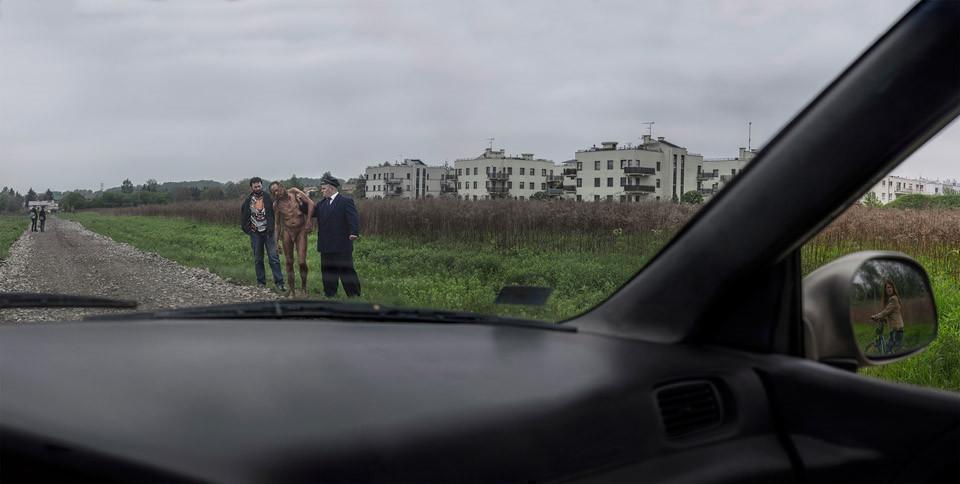Zbigniew Libera
Freelancer
Zbigniew Libera Freelancer (Self-portrait), 2013, diptych, photography, pigment ink on paper, ACP sheet, glass, wooden frames, 110 × 218, 110 × 146 cm (frames: 114 × 223, 114 × 151 cm), edition 3+2AP, copy #1/3
Collection II of the Arsenal Gallery in Białystok. Work purchased by the Podlaskie Association for the Promotion of Fine Arts

Freelancer, Zbigniew Libera’s photographic self-portrait as a social outcast, has an allegorical aspect, and the protagonist of the diptych is a type: an artist situated in the legal and socio-economic realities of contemporary Poland. The narrative framework is easy to decipher: a railway worker finds a naked man, living wild on the outskirts of a city housing estate. Leading him, the railway man holds him by the arm like an escapee. Two shots of the captured man, from afar and close up, were taken from inside a car. The scene is watched by accidental witnesses, some seen only as reflections in the rear-view mirrors of the car. The atmosphere of these photographs: a threatening situation in connection with the menacing, death-like emptiness of the housing estate, brings to mind another of Libera’s works: the panorama entitled The Exodus of People from the Cities (2010).
A freelancer and an outsider: these are the two contrasting aspects of the social image of an artist. Free from the constraints of a contract that would dictate the premises of employment, a freelancer is, to a certain extent, an autonomous being; this status is usually associated with creative individuals, including artists. Libera ironically calls this freedom into question. Freelancers are denied the privileges granted by formalised employment, and the present-day Polish system of social and health insurances does not favour freelance work. A freelancer may, paradoxically, be trapped by his freedom. Libera has many times called attention to the artists’ difficult financial situation, for instance during the Day Without Art (2012), a nationwide strike of the artists .
The image of the outcast artist greatly resembles that of Christ. For example, in the photograph taken from the distance, Libera assumes a pose familiar from the iconography of the Flagellation, while in the close-up, a wound similar to that of Christ is discernible below his ribs. The compositional layout refers to Albrecht Dürer’s drawing Self-Portrait in the Nude (ca. 1509, Residenzschloss, Weimar), and also, due to the details, e.g. the gaze, and the conception, to Dürer’s Self-Portrait (1500, Alte Pinakothek, Munich), where the artist showed himself in the convention of medieval representations of Christ. Also, the image of a “martyr” conforms to the Romantic conception of a poet as a messiah taking the suffering of the nation onto himself. Giving some nuance to the diptych’s social involvement, the metaphorical aspect makes it more universal in its essence.
Izabela Kopania
translated from Polish by Klaudyna Michałowicz

PLAN YOUR VISIT
Opening times:
Thuesday – Sunday
10:00-18:00
Last admission
to exhibition is at:
17.30